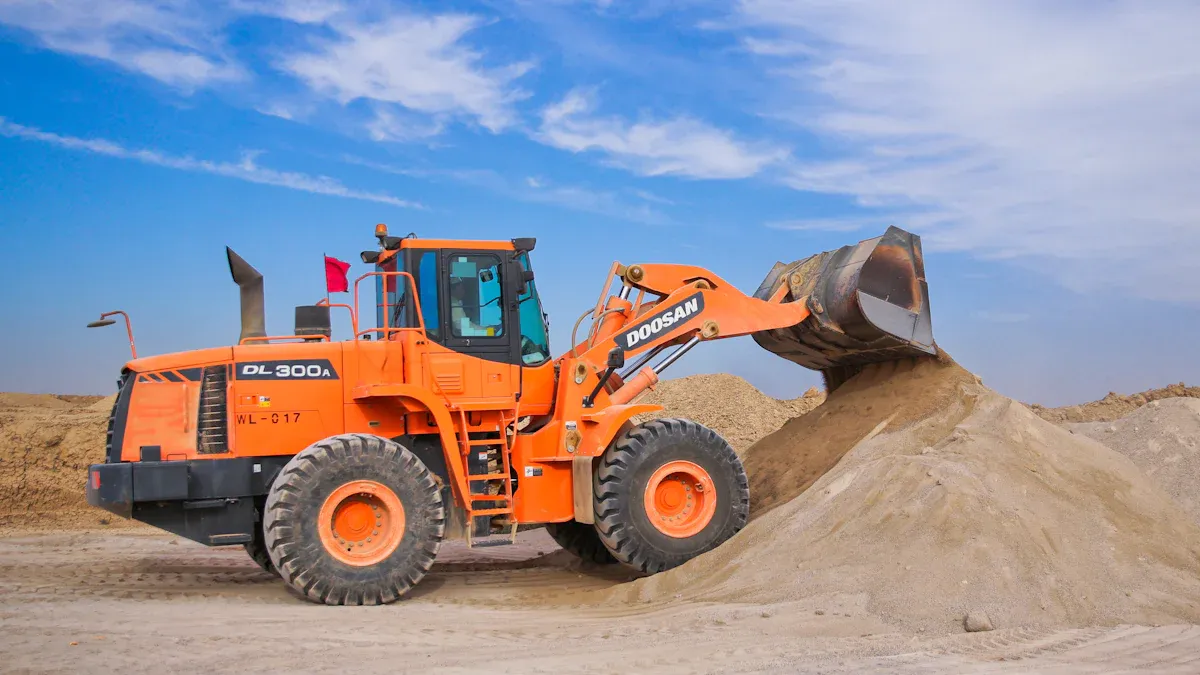
Ensuring compatibility between bucket teeth and bucket adapters is critical for optimal equipment performance. Proper fitment of bucket tooth components enhances digging and grading capabilities, extends durability, and minimizes downtime. For instance, using the correct excavator rock tooth prevents breakdowns and increases productivity. Regular measurements and inspections of these parts play a vital role in maintaining operational efficiency and reducing replacement costs.
Key Takeaways
- Check pin types and retainer sizes to ensure they match. Wrong sizes can cause problems and wear out parts faster.
- Use tools like calipers and gauges to measure correctly. This makes sure bucket teeth stay tight on the adapters.
- Ask experts for help with tricky fit issues. Their advice can fix problems and improve how equipment works.
Key Factors for Bucket Tooth Compatibility
Pin Type and Retainer Size
The pin type and retainer size play a crucial role in ensuring the compatibility of bucket teeth with adapters. These components secure the bucket tooth in place, preventing movement during operation. A mismatch in pin type or retainer size can lead to loose fittings, reducing efficiency and increasing wear. Manufacturers often design pins and retainers to specific dimensions, so verifying these measurements is essential. High-quality materials and precise construction enhance durability and performance, especially in demanding environments.
Tooth Pocket Dimensions
Tooth pocket dimensions directly influence how well a bucket tooth fits onto an adapter. The pocket must align perfectly with the adapter’s shape to ensure a secure connection. Variations in dimensions can result in improper fitment, leading to operational inefficiencies. Measuring the width, depth, and angle of the tooth pocket is critical. This step ensures that the bucket tooth can penetrate materials effectively and withstand high-impact conditions. Proper alignment also optimizes wear life, reducing the need for frequent replacements.
Adapter Design and Wear Considerations
The design of the adapter significantly impacts compatibility. Adapters must accommodate the bucket tooth while maintaining structural integrity under stress. Wear and tear on adapters can alter their dimensions over time, affecting fitment. Regular inspections help identify wear patterns and ensure continued compatibility. Selecting adapters designed for specific applications, such as rock excavation or demolition, enhances performance. Understanding wear factors based on the materials being excavated also helps in optimizing the lifespan of both the adapter and the bucket tooth.
Tip: Using gauges to measure and verify dimensions ensures that bucket teeth and adapters remain compatible, even when working with parts from different suppliers.
Measuring and Verifying Fitment

Tools for Accurate Measurements
Accurate measurements are essential for ensuring that a bucket tooth fits seamlessly with an adapter. Precision tools such as calipers, micrometers, and gauges are indispensable for this process. Gauges, in particular, are designed to measure specific dimensions of bucket teeth and adapters, ensuring compatibility across different suppliers. Manufacturers often use advanced techniques like forging to enhance the strength and durability of these tools. Additionally, hardness tests, such as Rockwell or Brinell, and impact tests help verify the toughness of the materials used. These tools and tests ensure that the bucket tooth meets industry standards and performs reliably under demanding conditions.
Step-by-Step Measurement Process
A systematic approach to measurement ensures accuracy and consistency. First, clean the bucket tooth and adapter to remove debris that could affect the readings. Next, use calipers or gauges to measure critical dimensions, such as the tooth pocket width, depth, and angle. Record these measurements and compare them against the specifications provided by the supplier. Conduct visual inspections to check for uniformity, smooth surfaces, and the absence of defects. Repeat the process for multiple parts to ensure consistency across the batch. This thorough approach minimizes the risk of mismatched components.
Comparing Measurements with Supplier Specifications
Once measurements are recorded, compare them with the supplier’s specifications to confirm compatibility. Look for certifications such as ISO or ASTM, which indicate adherence to industry standards. Reputable manufacturers often provide detailed guidelines and testing certifications to ensure their products meet quality benchmarks. Compatibility with machinery and wear life are critical factors to consider. Longer wear life reduces maintenance costs and enhances operational efficiency. By following these steps, users can ensure that their bucket tooth fits perfectly with adapters from various suppliers.
Overcoming Common Fitment Challenges

Addressing Mismatched Sizes
Mismatched sizes between bucket teeth and adapters can disrupt operations and lead to equipment damage. To address this issue, users should measure both components with precision tools like gauges or calipers. These tools help identify discrepancies in dimensions, ensuring a proper fit. Manufacturers often provide detailed specifications for their products, which users can reference to verify compatibility. When mismatches occur, replacing the incompatible part with one that meets the required dimensions is the most effective solution. Regular inspections and measurements can prevent such issues from arising in the first place.
Solutions for Wear and Tear
Wear and tear on bucket teeth and adapters is inevitable, especially in demanding applications like rock excavation. However, several engineering solutions can enhance durability and extend service life:
- Excavator bucket teeth made of low-carbon steel are prone to wear but can be reinforced using Weld Overlay Cladding. This process adds a durable layer to the surface, improving resistance.
- Preheating during welding prevents cracks and ensures better adhesion.
- Using materials with higher hardness levels increases wear resistance, reducing the frequency of replacements.
Implementing these methods minimizes wear-related challenges, ensuring consistent performance and compatibility.
Consulting Experts for Complex Issues
For complex fitment challenges, consulting specialized professionals can provide valuable insights and solutions. Experts like Rimkus and Catalant offer tailored services to address intricate problems:
| Expert Service | Description |
|---|---|
| Rimkus | Specializes in materials failure analysis, corrosion investigation, and weld engineering services. |
| Catalant | Connects clients with highly-skilled consultants experienced in solving similar issues. |
These professionals utilize advanced testing facilities and industry expertise to resolve compatibility issues effectively. Their guidance ensures optimal performance and reduces downtime.
Accurate measurements and regular inspections are essential for ensuring compatibility between bucket teeth and adapters. Proper maintenance extends the lifespan of these components and prevents operational disruptions. Using precision tools like gauges simplifies the verification process. Consulting suppliers for expert advice ensures optimal performance and compatibility, even when working with parts from different manufacturers.
FAQ
How can users ensure compatibility between bucket teeth and adapters from different suppliers?
Users should measure critical dimensions using precision tools like gauges and compare them with supplier specifications to confirm compatibility.
Why are gauges essential for verifying fitment?
Gauges provide accurate measurements of bucket teeth and adapters, ensuring compatibility across various suppliers and reducing the risk of mismatched components.
What should users do if wear and tear affect fitment?
Users should inspect components regularly, replace worn parts promptly, and consider reinforcement techniques like Weld Overlay Cladding to extend service life.
Post time: Apr-08-2025